Laptop Mag Verdict
The Galaxy S5 packs a gorgeous display, enhanced camera and long-lasting battery into a water-resistant chassis, making it one of the best smartphones ever.
Pros
- +
Beautiful display
- +
Water-resistant chassis
- +
Improved camera is easier to use
- +
All-day battery life
Cons
- -
Inconsistent fingerprint reader
- -
Plastic body
- -
Annoying USB port flap
Why you can trust Laptop Mag
In a world where nearly everyone owns a smartphone, it's getting harder for companies to stand out. Samsung's Galaxy S5 isn't a game-changer, but it is one of the best smartphones money can buy. The S5 for T-Mobile ($0 down, $27.50 per month) tops its predecessor in every way, offering a gorgeous 5.1-inch display, improved camera and water-resistant chassis. Sure, the new built-in heart rate monitor isn't a must-have, but the integrated fingerprint reader is handy. Add in awesomely long battery life and there are a lot of reasons to make this your next handset.
Editor's Note: Portions of this review appeared in our original Galaxy S5 review.
Design

Once again, Samsung's flagship smartphone comes wrapped in a plastic chassis rather than metal, but that doesn't mean the Galaxy S5 is unattractive. The removable back sports a soft-touch finish with a dimpled pattern, which is a significant improvement over the Galaxy S4's slippery, glossy rear. You can take your pick of white or charcoal black.
Whereas the S4 had a more curved look with slightly rounded edges, the S5 (with its slightly bigger screen) has a taller, more rectangular appearance. Samsung also switched out the capacitive Settings button to the left of the Home button for a more convenient Recent Apps button.
MORE: 12 Surprising Things Your Android Phone Can Do
Like its predecessor, the IR blaster and headphone jack sit up top, with the power button and volume controls on the right and left sides, respectively. One unwelcome change will bug you every time you charge the device: In order to make the S5 water-resistant, Samsung decided to protect the microUSB port with a flap.
While we wouldn't necessarily classify the Galaxy S5 as a phablet, having larger dimensions than the S4 (5.6 x 2.9 x 0.31 inches versus 5.3 x 2.9 x 0.25 inches) makes it more difficult to use with one hand. In addition, the S5 weighs a heftier 5.1 ounces (up from 4.6 ounces on the S4).
Overall, the S5 feels solid but unsexy compared with the aluminum HTC One M8, but the latter device is a beefier 5.6 ounces and has a nonremovable backside.
Water Resistance
While Samsung needed to make a special active version of the Galaxy S4 to offer resistance to water, the S5 has that goodness baked in. With its IP rating of 67, this device can withstand a depth of 1 meter for 30 minutes. While you can't go swimming with the S5 like the Sony Xperia Z1s, which lets you take pictures underwater, Samsung's handset can survive accidental splashes and dunkings.
We dropped the S5 in a bowl of water for a few minutes and then picked it up and dried it off. The handset continued to work just fine. Just don't expect to operate the touch screen while submerged; our inputs didn't register.
Display
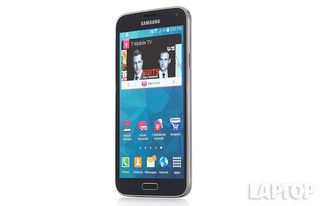
Click to EnlargeYou won't find a more gorgeous display on a smartphone. The Galaxy S5's 5.1-inch 1080p Super AMOLED screen is not only brighter than its predecessor, but also offers richer colors and better contrast than the HTC One M8. In a side-by-side comparison watching the "X-Men: Days of Future Past" trailer, Wolverine's face looked warmer and more detailed on the S5. The Samsung also offered deeper blacks, while the M8's looked cloudier.
The S5 averaged 596 lux on our light meter (378 nits), higher than the S4 (446 lux) and the One M8 (460 lux, 368 nits). Even more impressive, the latest Galaxy offers very accurate colors, as it registered a Delta-E score of 0.1 (lower numbers are better). The HTC One M8 scored 4.1 and the older S4 5.7, but the iPhone 5s was an even better 0.05.
The S5 produced more of the sRGB color gamut than the One M8 in our testing (151.3 percent versus 115). The iPhone 5s reached 98.4 percent.
Outdoors, the S5's Adapt Display mode (enabled by default) is supposed to analyze incoming light and what you're viewing to optimize color and sharpness on the fly. The S5's picture did look a bit brighter and richer than the iPhone 5s and considerably more so than the One M8.
MORE: iPhone 5s vs. Samsung Galaxy S5: And the Winner Is...
Audio
The Galaxy S5's single rear speaker got decently loud when we streamed Pharrell William's "Happy." Ultimately, though, HTC One M8's BoomSound speakers win hands-down. The M8 delivered deeper, richer audio on the same track, and the cymbals were much more pronounced.
Registering 70 decibels on the Laptop Mag audio test, the T-Mobile S5 is quieter than the One M8 (83 dB) and the LG G2 (80 dB).
Fingerprint Sensor

Click to EnlargeFollowing the lead of the iPhone 5s, the Galaxy S5 integrates a fingerprint reader into its home button for unlocking the device and signing into our Samsung account. However, unlike Apple's implementation, you can also use the sensor for making payments via PayPal. (You can't use your fingerprint to log into websites.)
Registering our fingerprint was fairly easy, and the S5 can store up to three digits. However, the S5 sometimes had trouble recognizing our swipes, reminding us to swipe the entire pad. We've found the Touch ID sensor on the iPhone 5s, upon which you just place a finger, to work more consistently.
The PayPal integration lets you pay for things on websites or apps that accept PayPal, as well as some physical stores. The good news is that we were able to bill a Newegg purchase of an SD Card using a swipe of our finger. The bad news is that it takes several steps to get set up, including downloading the latest PayPal app and linking your fingerprint to your account. In this example, we still needed to step through a couple more screens to fully complete our transaction.
Interface
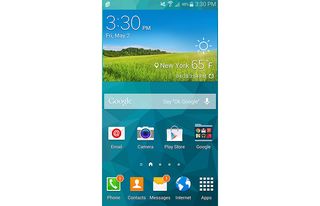
Click to EnlargeIn order to make its smartphones feel more intuitive to operate, Samsung applied a makeover to its TouchWiz interface, which runs atop Android 4.4.2 on the Galaxy S5. For example, the Settings menu has a flat look with colorful circles representing the options. The notification drawer also sports circular buttons, with 10 available quick-setting shortcuts, and 10 more if you enter grid view.
The S5's lock screen makes the camera shortcut larger to make it easier to launch the camera. However, Samsung took away the ability to use shortcuts to other apps from the lock screen, which power users won't appreciate.
Click to EnlargeThe main home screen of the S5 houses a weather widget up top and a Google search bar in the middle that supports voice search. Just say "OK Google" to find what you're looking for.
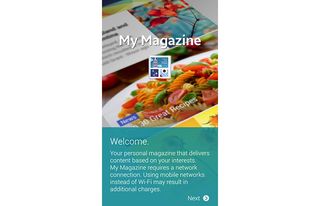
Click to EnlargeSwiping to the left launches My Magazine, a Flipboard-powered news reader that also sucks in social networking feeds from Google+, LinkedIn, Twitter and others but not Facebook.
The tile-based interface looks slick, and you can drill down into categories to choose your favorite media outlets.
As with the Galaxy S4, you can enable Multi Window to run two apps on the screen at once. This feature will come in handy for multitaskers who want to, say, drag a photo from the Gallery into an outgoing email. The Galaxy S5 supports 25 apps for split-screen use.
Samsung still insists on having its phones bloop and bleep when unlocking the device, turning off the screen and (of course) when receiving notifications. We turned the system volume down.
MORE: Galaxy S5 Features: What to Enable and Disable
Keyboard

Click to EnlargeIt might not seem like a big deal, but having a dedicated number row on the S5's keyboard is a huge time-saver. This feature carries over from the S4, as does predictive text and swiping via SwiftKey technology. Although the letters on this layout are smaller than on the HTC One M8, we didn't make many typos and appreciated the light haptic feedback
S Health and Heart Rate Monitor
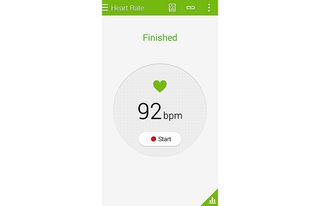
Click to EnlargeDo people want their smartphone to read their heart rate? As the interest in fitness trackers and "the quantified self" grows, Samsung hopes to tap into that trend with its redesigned S Health app, which can read your heart rate using a sensor on the back of the device. After holding our fingertip on the sensor for several seconds, the S5 displayed our heartbeats per minute.
We suppose this feature will satisfy the curiosity of some--and it could be a handy tool to use after a workout--but the novelty will likely wear off quickly for those who aren't particularly active. Besides, those who want to keep better tabs on their heart rate will probably choose a dedicated wearable device like the Samsung Gear Fit.
The S5 can also track your steps, calories burned and calories consumed. Assuming you have GPS turned on, the S5 can measure not only the distance you traveled but your elevation, making it a solid workout companion.
What's most impressive is S Health's ability to track your diet. Enter "yogurt parfait," for example, and the S5 will include results from multiple name brands and even restaurants. In this case we could select McDonald's, Dannon, Starbucks and several other options.
Performance
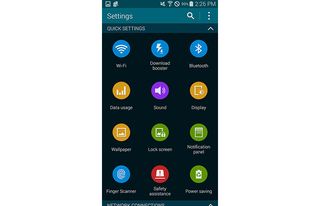
Click to EnlargeEquipped with a quad-core Qualcomm Snapdragon 801 processor and 2GB of RAM, the Samsung Galaxy S5 offered impressive performance numbers on our synthetic benchmarks and real-world tests.
For example, the Galaxy S5 took 18 seconds to open the resource-intensive game, "N.O.V.A. 3." The HTC One M8, which also includes a Snapdragon 801 processor and 2GB of RAM, opened the app in an equally speedy 17 seconds. LG's G Flex and its Snapdragon 800 CPU and 2GB of RAM, also opened the app in 17 seconds. The average smartphone takes 16 seconds.
Similarly, the Galaxy S5 took just 4 minutes and 42 seconds to transcode a 204MB, 1080p video file to 480p. That's much faster than the smartphone category average of 7:51 and blows away the LG G Flex's time of 6:34. HTC's One M8 took a slightly slower 4:47.
In side-by-side tests, the Galaxy S5 was a step behind the One M8 when exiting apps to the home screen, though turning off animations in settings can cut down the time. The two were neck and neck when changing screen orientations.
The S5 turned in an equally strong performance on the Geekbench 3 synthetic benchmark, scoring a solid 2,897. That's more than 1,000 points higher than the smartphone average of 1,837. The LG G Flex scored 1,967, while the HTC One M8 recorded a 2,480. Even Apple's iPhone 5s scored lower than the S5, registering a 2,556 on the test.
Camera Features
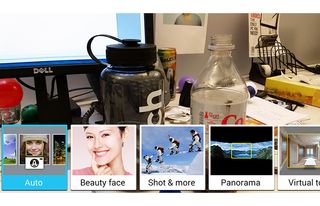
Click to EnlargeFaster, sharper and (somewhat) less cluttered, the Galaxy S5's 16-megapixel camera is the most improved feature versus the Galaxy S4.
The new Real Time HDR setting really impressed, as it lets you preview the high-dynamic range images before you take the shot. The iPhone 5s needs to capture the images first and stitch them together. When we photographed a New York City building, the camera brought out details that would otherwise be draped in shadows.

Samsung also deserves credit for combining multiple modes into one. Shot & More lets you apply all sorts of enhancements after you shoot, including Eraser Mode (for erasing photobombers), Best Face (for choosing the best expression on your subjects) and three other options. In our tests, though, the S5 had trouble picking out one face in a group photo.
The Galaxy S5's new Selective Focus feature brings some creative fun to photo-taking. By pressing a button on the left side of the screen, you can snap a shot and then decide afterward if you want the foreground or background in focus. The effect worked well when we shot a co-worker holding a soda bottle out in front of him, but we wish you could precisely select the focal point as you can with the HTC One M8.

Samsung says the Galaxy S5 is capable of focusing in one-third the time of its predecessor, 0.3 seconds as opposed to 1 second. We did notice the S5 was ready to fire faster when we attempted to take a shot of the product box.
Photo and Video Quality
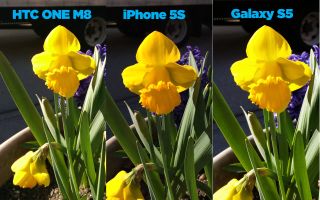
Overall, the S5 produced crisp and colorful images outdoors and slightly better-looking photos than its predecessor indoors. In a close-up shot of flowers, the Galaxy more than held its own versus the iPhone 5s. The S5's image had more even focus throughout and better details in the petals, but the yellow flower in the center had better contrast on the iPhone.
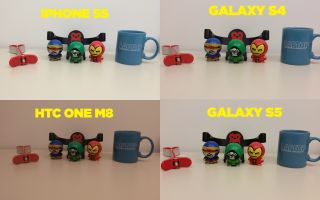
In another image we took of some tchotchkes indoors under fluorescent light, the Galaxy S5 produced richer colors, but the iPhone 5s' shot was brighter overall.


Click to EnlargeThe S5 fell flat when we shot some co-workers in a very dim room. Samsung's image came out unnaturally bright but quite fuzzy, especially when zoomed in. The iPhone 5s and One M8 produced more detailed photos. Turning on image stabilization in the S5's busy settings menu should help.
A selfie we snapped with the front 2.1-MP shooter in our office turned out bright, but our plaid tie was fuzzy around the edges.
[sc:video id="dheXE1cTpQ2VZjaPRlLr8LpGmwr_HP45" width="575" height="398"]
The Galaxy S5 captured pristine 1080p footage of New York City traffic. Yellow taxis popped, and we could make out small text on a passing Verizon FIOS truck. Audio was also quite clear.
MORE: Which Smartphones Have the Best Cameras?
Battery Life
Thanks to its larger 2,800 mAh battery, the Galaxy S5 lasted a seriously long 10 hours and 57 minutes on our Laptop Mag Battery Test. This test involves continuous Web surfing over 4G LTE with the display brightness set to 150 nits. The S5's runtime blows away the smartphone category average of 7:16 and makes the S5 for T-Mobile one of the longest lasting smartphones we've tested. By comparison, the HTC One lasted 9:52 on Verizon's LTE network.
Interestingly, T-Mobile's S5 also outlasted the AT&T, Sprint and Verizon versions of the same handset. On AT&T, the S5 lasted 9:42, while the Sprint model ran for 8:46. The Verizon edition turned in the shortest runtime of the lot, lasting 8:25.
On our previous battery test, which involved continuous Web surfing over LTE with the phone's display brightness set to 40 percent, the iPhone 5s ran for 5:46, while the LG G Flex lasted 10:57.
Apps
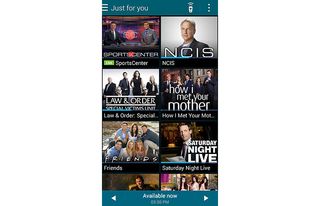
Click to EnlargeWhereas AT&T, Sprint and Verizon load up their Galaxy S5s with a host of bloatware apps, T-Mobile keeps its version of the handset relatively clean. Carrier-specific apps include T-Mobile Caller ID, T-Mobile TV, T-Mobile My Account, T-Mobile Visual Voicemail and Mobile Hotspot. Of those, only the T-Mobile Caller ID app isn't all that useful, as Android already has a built-in caller ID for people on your contact list.
MORE: Top 10 iPhone Alternatives
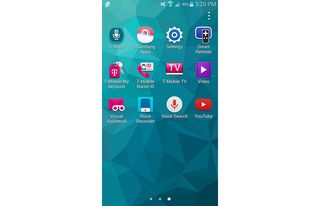
Click to EnlargeSamsung also bundles several of its own apps, including Smart Remote for controlling your TV and S Voice for Siri-like functionality. Parents will appreciate the Kids Mode app, which is weirdly buried in the Widgets menu. Once you create a profile for your child, they'll have a walled garden of kid-friendly apps, including a fun dinosaur that records what your child sings and then plays it back. You can also set time limits and whitelist additional apps.
Verdict
With its gorgeous display, powerful Snapdragon 801 processor and enhanced camera, the Samsung Galaxy S5 easily eclipses its predecessor along with nearly all other smartphones on the market. Oh, and let's not forget the fact that the S5 can go for a quick dip and keep on kicking. Plus, the T-Mobile S5 lasts nearly 11 hours on a charge, longer than the carrier models we tested.
Our only gripes with the Galaxy S5 are the inconsistent fingerprint reader (which should improve with an update) and the annoying USB port flap. Those who would prefer a premium metal design along with a cleaner interface and better audio quality should also consider the excellent HTC One M8. Overall, though, the Galaxy S5 ranks among the best smartphones ever made.
Samsung Galaxy S5 (T-Mobile) Specs
| Alternate Carriers | Sprint, AT&T, Verizon |
| Audio formats supported | MP4, MP3, AAC+, AAC |
| Bluetooth Type | Bluetooth 4.0 LE |
| Brand | Samsung |
| CPU | 2.5-GHz Quad-core Qualcomm Snapdragon 800 |
| Camera Resolution | 16MP |
| Carrier | T-Mobile |
| Company Website | www.samsung.com |
| Data | GSM, UMTS, LTE |
| Display (main) | 5.1-inch 1920 x 1080p Super AMOLED display |
| Display Resolution | 1920x1080 |
| Form Factor | Candybar Touchscreen |
| Front Camera Resolution | 2.1MP |
| GPS | Yes |
| Internal Memory | 16GB |
| Memory Expansion Type | miniSD Card |
| OS Family | Android |
| Operating System | Android 4.4 |
| Phone Display Size | 5.1 |
| Photo formats supported | TIFF, PNG, JPEG, BMP |
| Ports | 3.5mm headphone, microSD |
| Processor Family | Qualcomm Snapdragon 801 |
| RAM | 2GB |
| Size | 5.3 x 2.9 x 0.25 inches |
| Talk / Standby Time | 21 hours/ 16 days |
| Video formats supported | MPEG-4, AVI, WMA |
| Weight | 5.1 ounces |
| Wi-Fi | 802.11 a/b/g/n/ac |
